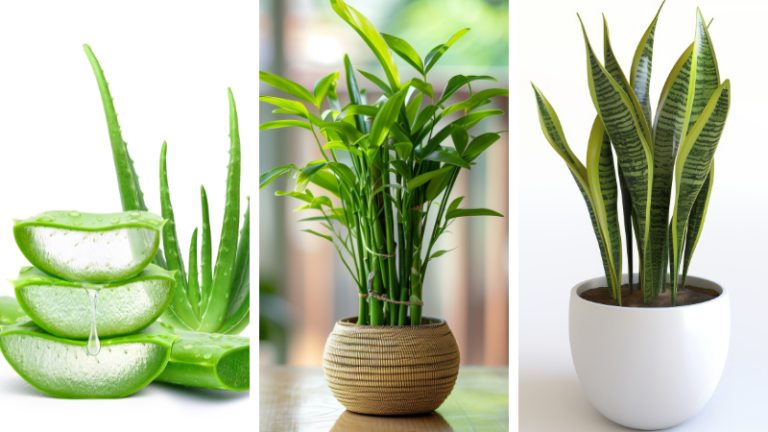Indoor plants do more than beautify our spaces. They purify the air, improve mental wellness, and even contribute to physical health. The right indoor plants can help create a more vibrant, healthier home. This guide covers the top 10 healthiest indoor plants for home use and offers tips for their care, placement, and benefits.
Benefits of the Healthiest Indoor Plants for Home
Introducing greenery indoors isn’t just for aesthetics; it has scientifically proven health benefits. According to the American Lung Association, certain plants can remove airborne toxins such as formaldehyde, benzene, and trichloroethylene, often emitted from household items. Indoor plants like the snake plant are known for their unique oxygen-releasing properties at night, which is discussed in this Snake Plant Benefits and Care Guide.
Additionally, plants contribute to mental wellness. Research from the National Institutes of Health highlights that plants can reduce stress and enhance relaxation. With that in mind, here’s a breakdown of the top 10 healthiest plants and how each can benefit your indoor environment.
The Top 10 Healthiest Indoor Plants for Home
1. Spider Plant: One of the Best Indoor Plants for Health
- Air Purification: Known to effectively remove formaldehyde and xylene.
- Care: Water when the soil feels dry and place in bright, indirect light.
- Placement: Safe for pets and versatile for any room.
- Check out our comprehensive guide on Spider Plant Benefits and Care.
2. Peace Lily: A Top Air-Purifying Plant for Home
- Benefits: Reduces humidity, helping prevent mold, and removes ammonia.
- Care: Keep soil moist, with moderate light.
- Placement: Ideal for bathrooms and kitchens where humidity levels are higher.
3. Aloe Vera: A Healthiest Indoor Plant with Healing Properties
- Healing Properties: The gel soothes minor burns and skin irritations.
- Air Quality: Known to clear the air of formaldehyde and benzene.
- Care: Needs bright, indirect sunlight and minimal watering.
- For a detailed overview of its benefits, refer to Aloe Vera Benefits and Uses.
4. Snake Plant: Healthiest Houseplant for Nighttime Oxygen
- Nighttime Oxygen Release: Ideal for bedrooms due to its nighttime oxygen production.
- Care: Very low-maintenance, requiring water only every two weeks.
- Placement: Great for bedrooms and offices with limited space.
5. English Ivy: An Indoor Plant for Wellness and Air Quality
- Allergy Reduction: Reduces airborne mold and allergens.
- Care: Thrives in moderate light; regular watering.
- Placement: Perfect for hanging baskets in the living room or kitchen.
6. Rubber Plant: One of the Healthiest Plants for Air Purification
- CO2 Removal: Highly efficient at absorbing carbon dioxide.
- Care: Prefers indirect sunlight with regular watering.
- Placement: Ideal for living rooms or office spaces for aesthetic and air-purifying benefits.
7. Areca Palm: Best Indoor Plant for Humidity and Air Quality
- Humidity Booster: Adds moisture to the air, ideal for drier environments.
- Air Quality: Removes toxins like xylene and toluene.
- Care: Requires bright, indirect light and regular watering.
8. Bamboo Palm: Top Plant for Air Quality Indoors
- Air Purification: Filters benzene and formaldehyde.
- Care: Thrives in low-light conditions and high humidity.
- Placement: Ideal for shaded hallways or dimly lit rooms.
9. Golden Pothos: Adaptable and Best Indoor Plant for Beginners
- Adaptability: Tolerates low light and irregular watering.
- Air Purification: Known for removing formaldehyde.
- Placement: Ideal for offices, bathrooms, or kitchens.
10. Lavender: A Healthiest Houseplant for Stress Reduction
- Stress Reduction: Known for its relaxing scent, helping with sleep and stress.
- Care: Full sunlight and well-drained soil.
- Placement: Great for sunny windowsills, particularly in bedrooms.
Choosing and Caring for the Healthiest Indoor Plants for Home
Factors to Consider
When choosing plants, consider:
- Light Levels: Identify which rooms get ample sunlight and which areas are shaded.
- Space and Size: Choose plants that suit your room dimensions.
- Pet Safety: Some plants can be toxic to pets. The ASPCA has a comprehensive list of pet-safe plants.
Basic Care Tips
- Watering: Most plants thrive when the soil is allowed to dry between waterings. Avoid over-watering.
- Sunlight: Many plants prefer indirect light, but species like aloe vera and lavender need direct sunlight.
- Humidity: Some plants, like the peace lily, benefit from high humidity and regular misting.
FAQs on Healthiest Indoor Plants
What are the easiest indoor plants for beginners?
Spider plants, snake plants, and golden pothos are resilient and low-maintenance, ideal for beginners.
How many plants should I have in a room?
For effective air purification, aim for one plant per 100 square feet.
Which plants improve air quality the most?
Spider plants, peace lilies, and areca palms are highly effective at filtering toxins.
Are there any indoor plants that are toxic to pets?
Yes, some plants, like peace lilies, can be harmful to pets. See the ASPCA’s list of pet-safe plants for more information.
Conclusion
Integrating these top 10 plants into your home can greatly improve air quality, mental health, and overall well-being. With benefits like stress relief from lavender and oxygen-boosting properties from the snake plant, each plant on this list offers unique advantages for a healthier indoor space. Explore more indoor plant care tips, such as Boost Your Plants with Manure Tea for an organic nutrient boost, to enhance the vitality of your indoor garden.
